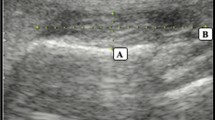Abstract
Background
This study aimed to explore the changes in the masseter muscle after curved osteotomy of the prominent mandibular angle and to supply guidance for resection of the mandibular angle.
Methods
Ultrasonography was used to assess changes in the thickness of the masseter muscle after curved osteotomy for 10 patients (20 hemimandibles) at the 6-month following-up assessment. The measurements were performed under both relaxing and maximal clenching positions through three cross sections of the masseter muscle (planes A, B, and C). Plane A contains the line from the mouth angle to the ipsilateral ear lobe. Planes B and C are parallel planes above and below plane A with a distance of 1 cm between them.
Results
No significant difference between the preoperative and postoperative thicknesses of the masseter muscle for planes A and B (p > 0.05) was found, but there was a significant difference (p < 0.05) for plane C. The postoperative thickness of the masseter muscle in plane C was reduced by 0.244 ± 0.121 cm in the relaxing position and by 0.244 ± 0.142 cm in the clenching position, which were respectively 19.22% ± 7.785% and 15.404% ± 7.648% of its original thickness. There was no significant difference in the contraction amplitude of the masseter muscle under maximal clenching (p > 0.05) for any of the three cross sections postoperatively.
Conclusions
The masseter muscle around the mandibular angle becomes atrophied but without functional defect after curved osteotomy. Patients with prominent mandibular angles can be treated simply with curved osteotomy instead of masseter excision.




Similar content being viewed by others
References
Kim NH, Chung JH, Park RH, et al. (2005) The use of botulinum toxin type A in aesthetic mandibular contouring. Plast Reconstr Surg 115:919–930
Lee Y, Kim JH (1999) Mandibular contouring: A surgical technique for the asymmetrical lower face. Plast Reconstr Surg 104:1165–1171
Deng J, Newton NM, Hall-Craggs MA, et al. (2000) Novel technique for three-dimensional visualization and quantification of deformable, moving soft tissue body parts. The Lancet 356:127–131
Kubota M, Nakano H, Sanjo I, et al. (1998) Maxillofacial morphology and masseter muscle thickness in adults. Eur J Orthod 20:535–542
Raadsheer MC, Van Eijden TM, Van Spronsen PH, et al. (1994) A comparison of human masseter muscle thickness measured by ultrasonography and magetic resonance imaging. Arch Oral Biol 39:1079–1084
Dutedoo HS (1978) Transtative and transformative growth of the rat mandible. Acta Odontol Scand 36:25
Hu J, Wang DZ, Zou SJ (1999) Surgical correction of square mandible by an intraoral approach. J Clin Stomatol 14:25–26
Chen Xiaoping, Song Jianliang, Tan Xiaoyan, et al. (1998) Correction of square face. Chin J Plast Surg Burns 14:169–172
Lo LJ, Mardini S, Chen YR (2005) Volumetric change of the muscles of mastication following resection of mandibular angles: A long-term follow-up. Ann Plast Surg 54:615–621
Fan HD, Wang X, Zhang X, et al. (2001) Angle-splitting ostectomy for the treatment for the mild or moderate enlarged mandibular angle with masseter muscle hypertrophy. J Modern Stomatol 15:18–20
Baek SM, Baek RM, Shin MS (1994) Refinement in aesthetic contouring of the prominent mandibular angle. Aesth Plast Surg 18:283–289
Baek SM (1991) Aesthetic contouring of the facial skeleton. Probl Plast Reconstr Surg 11:673
Yan BZ, Dong FS, Gui L (2005) The changes of the creatine activity after one-stage ostectomy of the mandibular angle. J Modern Stomatol 19:84–85
Hong SS, Chul G (1997) Masseter muscle atrophy after ostectomy of the mandibular angle in rabbits. Plast Reconstr Surg 99:51–59
Du BJ, Liu DL, Liang L, et al. (2005) Change of masseter muscle after the angle-grinding ostectomy for the enlarged mandibular angle. Acta Academiae Medicinae Militaris Tertiae 27:2376–2378
Mackool RJ, Hopper RA, Grayson BH, et al. (2003) Volumetric change of the medial pterygoid following distraction osteogenesis of the mandible: An example of the associated soft-tissue changes. Plast Reconstr Surg 111:1804–1807
Amir A. Jamali, Pouya Afshar, Reid A, et al. (2000) Skeletal muscle response to tenotomy. Muscle Nerve 23:851–862
Hylander WL, Johnson KR (1997) In vivo bone strain patterns in the zygomatic arch of macaques and the significance of these patterns for functional interpretations of craniofacial form. Am J Phys Anthropol 102:203–232
Yan BZ, Dong FS, Gui L (2004) The effect of the curved osteotomy of the mandibular angle on oral physiological function. J Modern Stomatol 18:161–162
Fu YG, Liu DL, Shan L, et al. (2006) Influence of the mandibular angle contouring surgery with and without partial resection of the masseter on the mandible motor function. Chin J Clin Rehabil 10:134–135
Jia XF, Huang JL (2005) Changes in myosin heavy chain mRNA in masseter muscle after ostectomying the mandibular angle in rabbits. J Southeast Univ Med Sci Edition 24:304–306
Yao J, Hu M (2004) Muscular tissue of masseter muscle and its functional injury after decollement of muscles. Chin J Clin Rehabil 29:6420–6421
Liu J, Zhang YR, Zhang Y (2002) Properties of biomechanics and muscle architecture in human masseter and temporolis. J Pract Stomatol 18:294–297
Author information
Authors and Affiliations
Corresponding author
Rights and permissions
About this article
Cite this article
Li, M., Gui, L., Liu, J.F. et al. Changes in the Masseter Muscle After Curved Osteotomy of the Prominent Mandibular Angle. Aesth Plast Surg 31, 732–738 (2007). https://doi.org/10.1007/s00266-007-0084-5
Received:
Accepted:
Published:
Issue Date:
DOI: https://doi.org/10.1007/s00266-007-0084-5




